DOI: https://doi.org/10.1073/pnas.2310039121
PMID: https://pubmed.ncbi.nlm.nih.gov/38215182
تاريخ النشر: 2024-01-12
تحكم خشونة العيوب في الزلازل الناتجة عن الحقن
الملخص
تسود خشونة السطح بشكل شائع في العيوب الطبيعية عبر مقاييس طولية مختلفة. على الرغم من الدراسات الواسعة التي تبرز الدور المهم لجيومترية العيوب في ديناميات الزلازل التكتونية، إلا أن تأثير خشونة العيوب على الزلازل الناتجة عن السوائل وكيفية تأثيرها لا يزال غامضًا. هنا، نحقق في تأثيرات جيومترية العيوب وتغاير الإجهاد على انزلاق العيوب الناتج عن السوائل وخصائص الزلازل المرتبطة باستخدام تجارب مختبرية ونمذجة عددية. نقوم بإجراء تجارب حقن السوائل على عينات من الحجر الرملي الغني بالكوارتز تحتوي على عيب ناعم أو خشونة. نجد أن الخشونة الهندسية تبطئ انزلاق العيوب الناتج عن الحقن وتقلل من سرعات الانزلاق الكلية ومعدلات ضعف الانزلاق. تتحكم تغاير الإجهاد والخشونة في توزيع مركز الزلزال، وخصائص التردد-الحجم، وآليات المصدر للانبعاثات الصوتية الناتجة عن الحقن (المماثلة للزلازل الطبيعية). على عكس العيوب الناعمة حيث يتم توزيع الانبعاثات الصوتية الناتجة عن الحقن بشكل موحد، فإن الانزلاق على العيوب الخشنة ينتج انبعاثات صوتية موضعية مع آليات مصدر غير مزدوجة واضحة. نوضح أن هذه الانبعاثات الصوتية المجمعة تحدث حول النقاط ذات الإجهاد العالي حيث تكون معدلات الانزلاق المحلية الناتجة أعلى، مصحوبة بانخفاض في مقياس غوتنبرغ-ريختر.
الملخص
أهمية الزلازل الناتجة عن السوائل المرتبطة بالأنشطة الصناعية، مثل التخلص من المياه العادمة، وإنتاج الطاقة الحرارية الجوفية، و
التوزيع المكاني، وخصائص التردد-السعة، وآليات المصدر للأحداث الناتجة عن الحقن. من أجل مزيد من التحليل للتأثيرات الملحوظة لعدم تجانس العيوب والإجهاد، نقارن البيانات التجريبية بنتائج النمذجة العددية لانزلاق العيوب على العيوب الملساء والخشنة.
النتائج
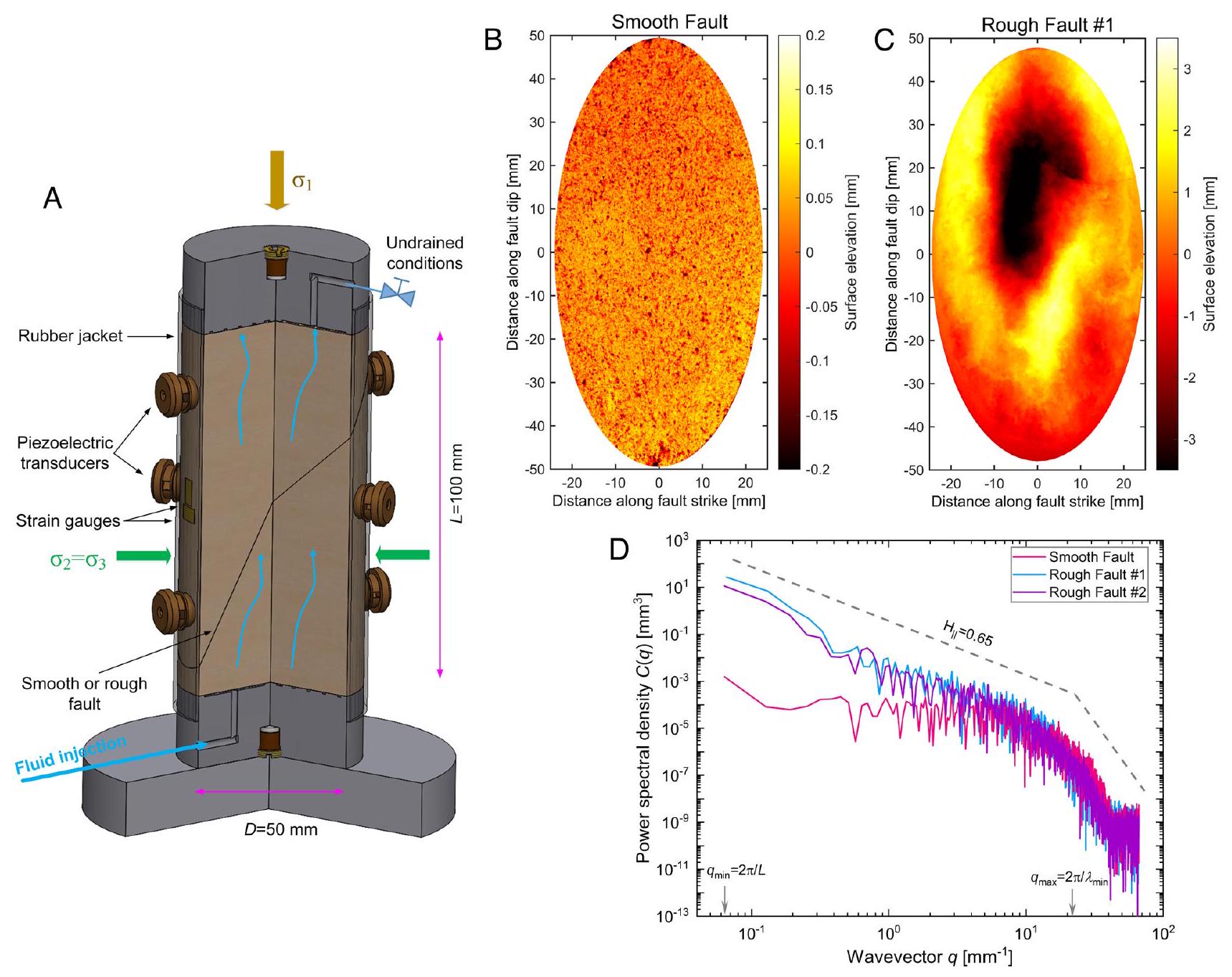
عينات أسطوانية تحتوي على واجهة صدع مقطوع بالمنشار أو صدع خشن مائل عند
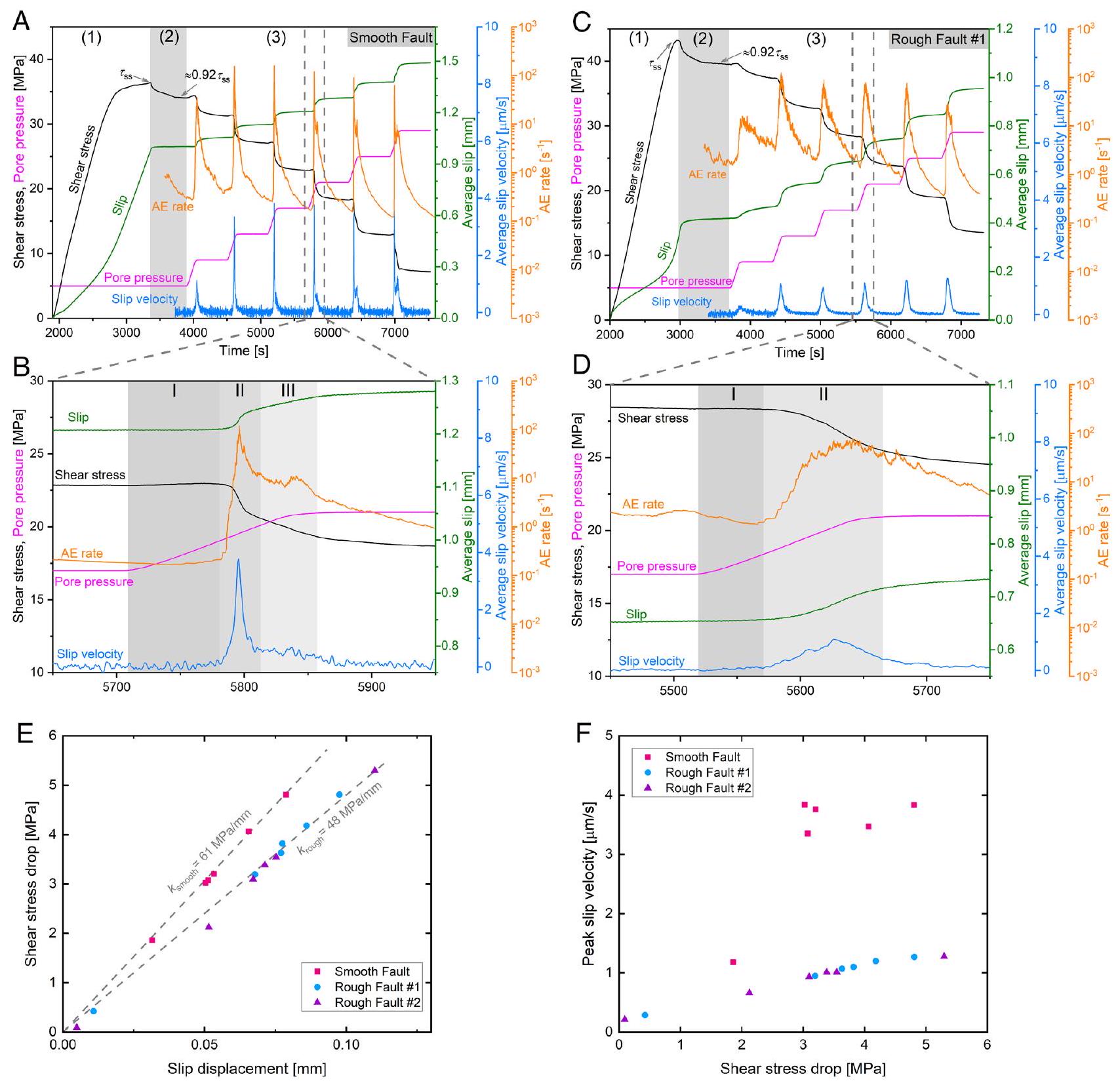
(ملحق SI، القسم 3). توفر الخصائص المكانية والسمات الإحصائية للانبعاثات الصوتية رؤى أساسية حول دور اختلاف خشونة السطح في الزلازل الناتجة عن السوائل.
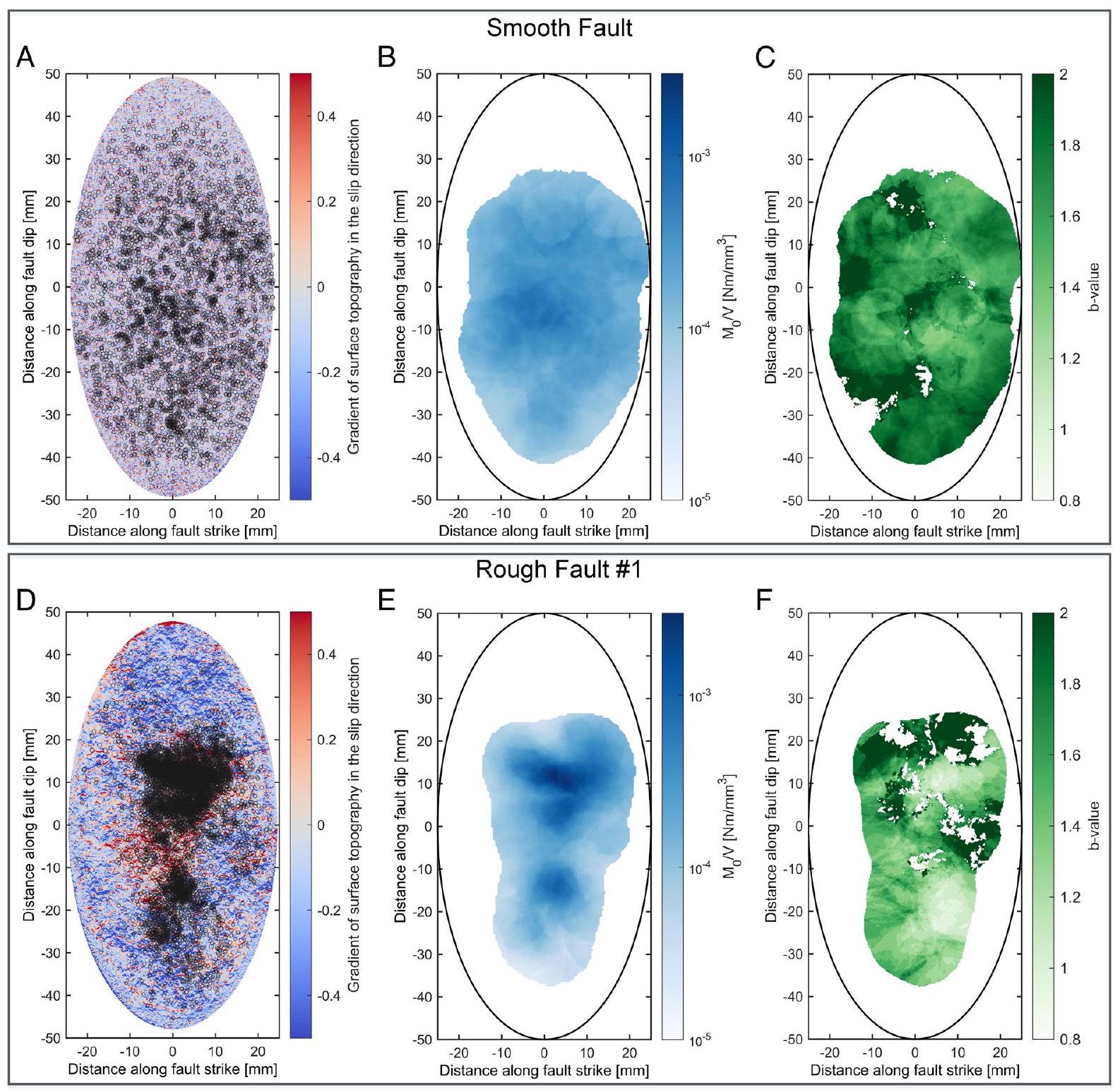
عند الانحناءات المقيدة، مما يظهر أيضًا توزيعًا كثيفًا لأحداث الانبعاث الصوتي (الشكل 3D). تكون تشكيلات متعددة من مستويات القص التي تستوعب الانزلاقات المحلية أكثر وضوحًا بالنسبة للعيوب الخشنة (ملحق SI، الشكل S11D). يتوافق الضرر الناتج عن الشقوق خارج العيب مع توزيع كثافة الانبعاثات الصوتية الذي ينخفض مع المسافة من سطح العيب (ملحق SI، الشكل S12). يتميز التجمع التدريجي للانبعاثات الصوتية الناتجة عن حقن السوائل بوجود ذروة في توزيع كثافة الانبعاثات الصوتية المركز حول واجهة العيب، وانخفاض سريع نحو الصخور الجانبية المجاورة، متسق مع الدراسات المخبرية السابقة حول انتشار الشقوق والانزلاق (23) والزلازل الطبيعية الموثقة عبر العيوب الانزلاقية في كاليفورنيا (63).
(66، 67)، يمكن تصنيف آلية مصدر الانبعاثات الصوتية إلى نوع قص أو انضغاط أو توتر. تُظهر تحليل متوسط القطبية توافقًا جيدًا مع نتائج حل FMT، مما يشير إلى هيمنة أحداث من نوع القص والانضغاط (الشكل.
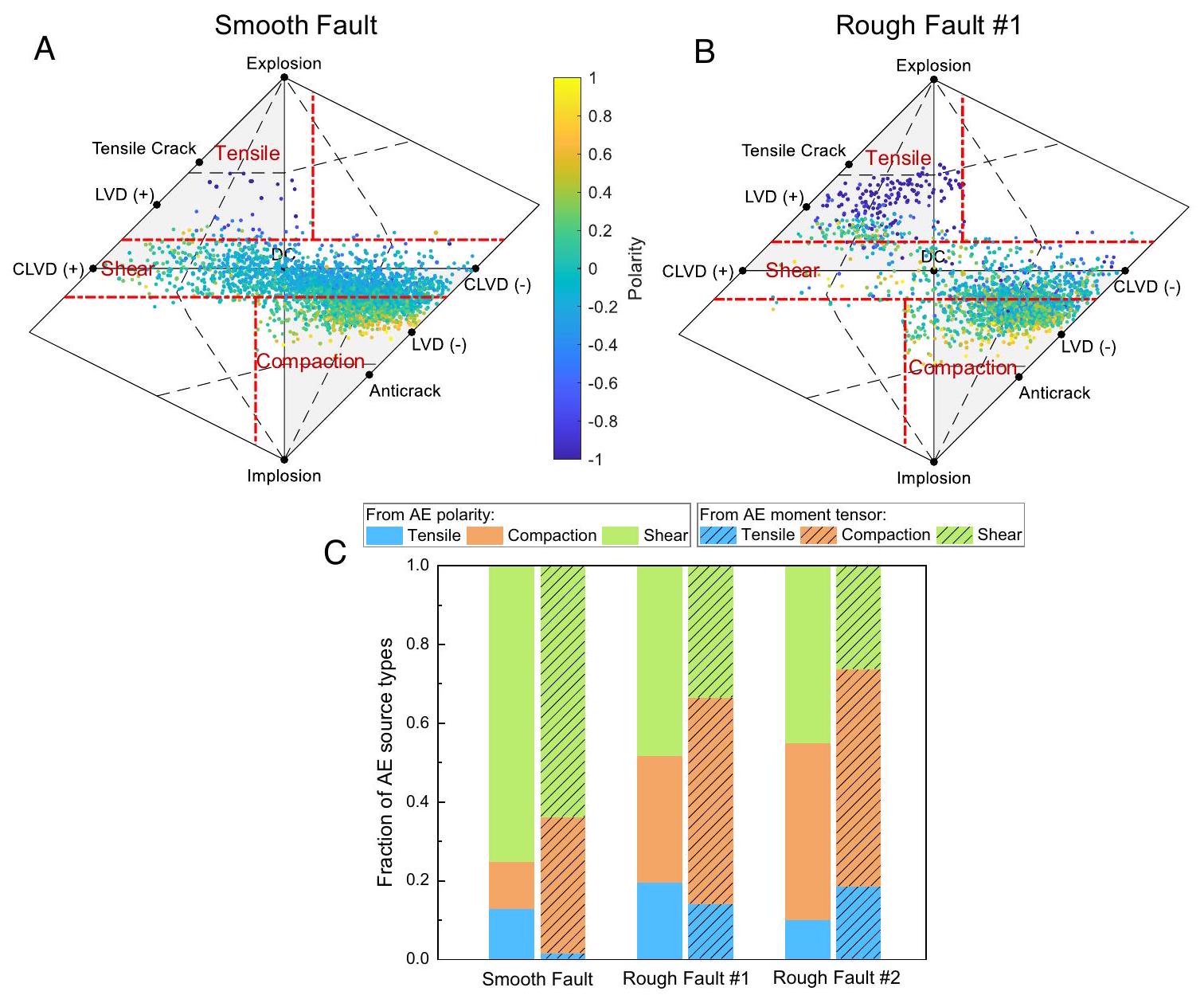
في رمل بنتهايم (الملحق SI، القسم 11). تتوافق بدايات الانزلاق المودلة، وسرعات الانزلاق القصوى، والتذبذبات الصغيرة اللاحقة في معدلات الانزلاق على طول الصدوع الأملس بشكل جيد مع البيانات التجريبية (الشكل 5A). تؤدي الضغوط العادية والقص المتجانسة وزيادات ضغط السوائل الموزعة عبر الصدع الأملس إلى انزلاق ومعدلات انزلاق متجانسة مكانيًا، كما هو موثق من خلال توزيع AEs المحددة (الشكل 5B).
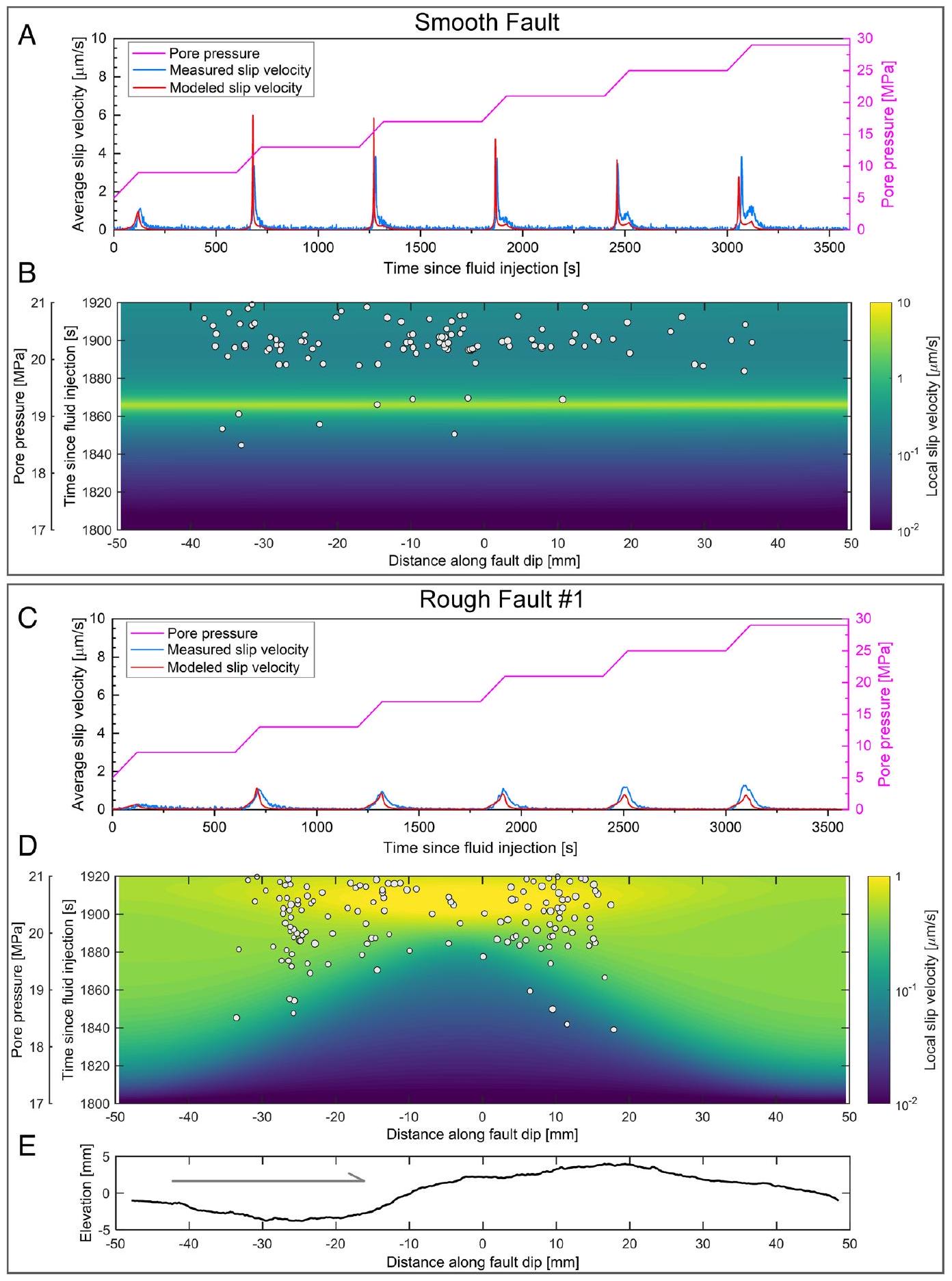
معدل انزلاق محلي مرتفع، مصحوبًا بانفجار محلي حاد في نشاط AEs (الشكل 5D). تتفق هذه النتيجة مع التوزيع المكاني لنشاط AEs الناتج عن الحقن حول النتوءات ذات الضغط العالي حيث يكون إطلاق اللحظة الزلزالية الناتجة عن AEs مرتفعًا ولكن القيمة المرتبطة به
المناقشة
ديناميكا الزلازل، مع زيادة نسبة مكونات العزم غير الزوجي في موترات الزلازل للصدوع الخشنة. تُعزى الزلازل الطبيعية ذات الآليات غير الزوجية عادةً إلى تعقيد الصدع (72). بالنسبة للصدوع غير المستوية، قد يؤدي التطور الوفير لشبكات الكسور المتقاطعة والتغيرات المحتملة في الخصائص المرنة المتعلقة بالأضرار في منطقة المصدر إلى تعديل مجالات الضغط المحلية والتسبب في انحراف متجه الانزلاق عن سطح الصدع الرئيسي (7، 24، 59). بالنسبة للصدوع الخشنة، نجد أن النشاط الزلزالي الناتج عن الحقن يتركز في محيط النقاط ذات الضغط العالي حيث يتم إطلاق لحظة زلزالية كبيرة، مصحوبة بانخفاض
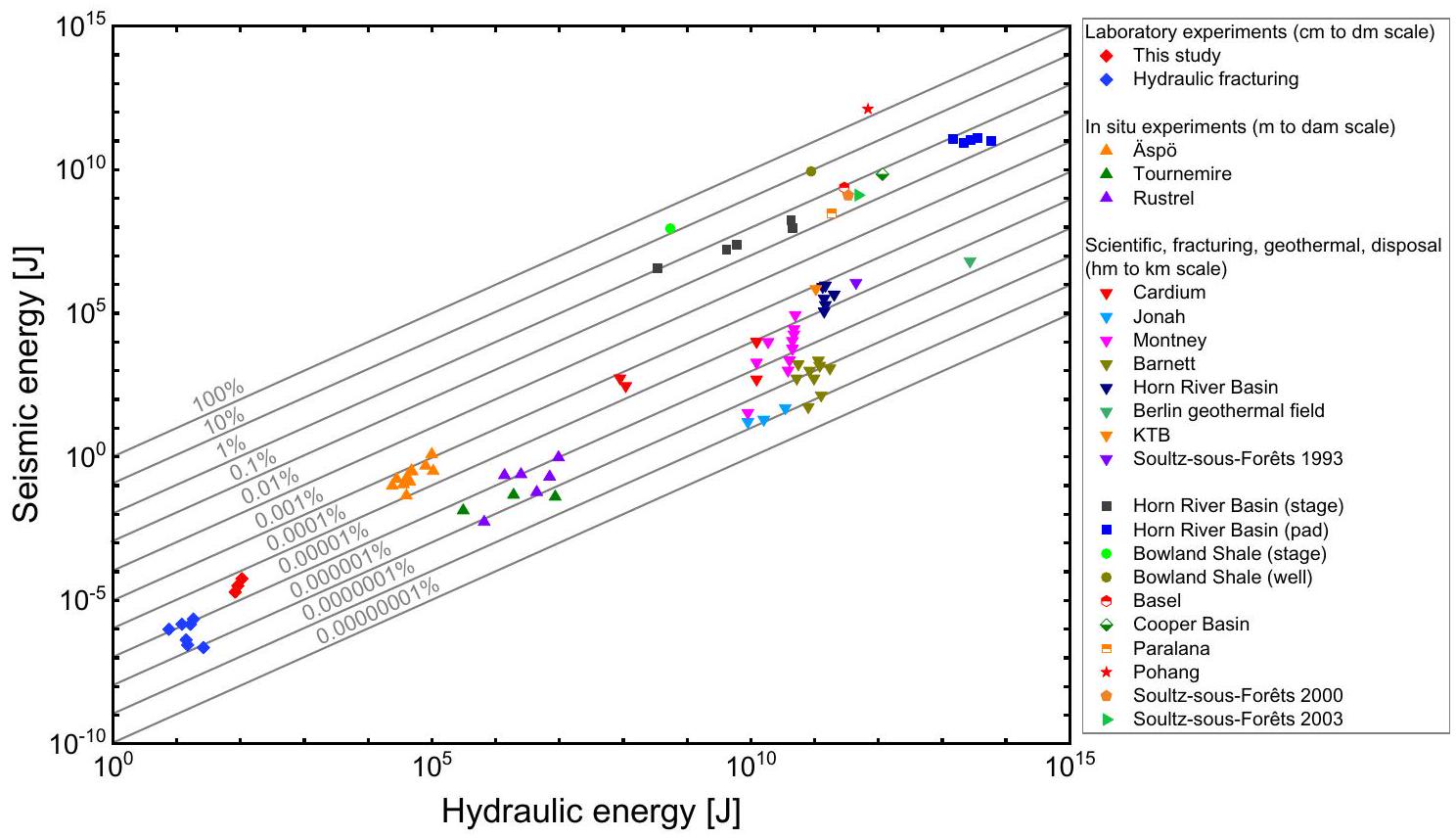
تنتج انخفاضات عالية في الإجهاد المحلي ومعدلات انزلاق، وإطلاق لحظي زلزالي كبير وانخفاض

المواد والطرق
الإجهادات العادية. بالنسبة لكل كتلة، يتم التحكم في الانزلاق الاحتكاكي بواسطة قانون احتكاك يعتمد على المعدل والحالة.
الشكر والتقدير. نشكر ستيفان جيرمان على المساعدة في إعداد العينات والأقسام الرقيقة. نحن ممتنون لفاليريان شوشتر على ملاحظات المجهر الضوئي للأقسام الرقيقة. استفاد المخطوط من المناقشات البناءة مع جاي فاينبرغ، توماس غوبل، ونيكولاس برانتوت. نشكر المراجعين بول سيغال وجريج هيرث، والمحرر على التعليقات والأفكار القيمة التي حسنت بشكل كبير الدراسة الحالية. يعترف ل.و. بتمويل ما بعد الدكتوراه المقدم من مركز هيلمهولتز في بوتسدام، مركز الأبحاث الجيولوجية الألمانية. يعترف ج.د. بتمويل مشروع BMBF STIMTEC-X 03G0901C.
- أ. ساجي، إ. إ. برودسكي، ج. ج. أكسن، تطور خشونة سطح العطل مع الانزلاق. الجيولوجيا 35، 283-286 (2007).
- W. L. باور، T. E. توليس، نماذج إقليدية وفراغية لوصف خشونة سطح الصخور. مجلة أبحاث الجيوفيزياء. الأرض الصلبة 96، 415-424 (1991).
- إي. إي. برودسكي، ج. د. كيركباتريك، ت. كانديلا، القيود الناتجة عن خشونة العيوب على القوة المعتمدة على المقياس للصخور. الجيولوجيا 44، 19-22 (2016).
- F. رينار، T. كانديلا، E. بوشود، الثبات البُعدي لخشونة العيوب من مقياس الميكرو-تشققات إلى مقياس القارات. رسائل أبحاث الجيوفيزياء 40، 83-87 (2013).
- T. كانديلا وآخرون، خشونة أسطح العيوب على مدى تسعة عقود من مقاييس الطول. مجلة أبحاث الجيوفيزياء. الأرض الصلبة 117، B08409 (2012).
- جي. إتش. ديترش، بي. دي. كيلغور، الملاحظة المباشرة للاتصالات الاحتكاكية: رؤى جديدة لخصائص تعتمد على الحالة. الجيولوجيا الفيزيائية النقية والتطبيقية 143، 283-302 (1994).
- F. M. تشيستر، ج. س. تشيستر، الإجهاد والتشوه على طول الفوالق المتموجة الاحتكاكية. مجلة أبحاث الجيوفيزياء. الأرض الصلبة 105، 23421-23430 (2000).
- جي. إتش. ديترش، دي. إي. سميث، العيوب غير المستوية: ميكانيكا الانزلاق والأضرار خارج العيب. الجيولوجيا الفيزيائية النقية والتطبيقية 166، 1799-1815 (2009).
- س. ر. براون، ج. هـ. شولتز، إغلاق الأسطح المرنة العشوائية في الاتصال. مجلة أبحاث الجيوفيزياء. الأرض الصلبة 90، 5531-5545 (1985).
- Z. Fang، E. M. Dunham، مقاومة القص الإضافية الناتجة عن خشونة العيوب ومستويات الضغط على العيوب المعقدة هندسياً. مجلة أبحاث الجيوفيزياء. الأرض الصلبة 118، 3642-3654 (2013).
- ن. يوشيوكا، ج. هـ. شولتز، الخصائص المرنة للأسطح المتلامسة تحت الأحمال العمودية والقصية: 1. النظرية. مجلة أبحاث الجيوفيزياء. الأرض الصلبة 94، 17681-17690 (1989).
- Y. Tal، B. H. Hager، J. P. Ampuero، تأثيرات خشونة العيوب على عملية نشوء الزلازل. J. Geophys. Res. Solid Earth 123، 437-456 (2018).
- س. و. أوزاوا، ت. هاتانو، ن. كامي، هجرة أطول وتدهور عفوي لنبضة الانزلاق غير الزلزالي الناتجة عن خشونة الفوالق. رسائل أبحاث الجيوفيزياء 46، 636-643 (2019).
- سي. كاتانيا، بي. سيجال، الانزلاق البطيء المسبق والهزات التمهيدية على الفوالق الخشنة. مجلة أبحاث الجيوفيزياء. الأرض الصلبة 126، e2020JB020430 (2021).
- س. أوزاوا، ر. أندو، محاكاة تسلسل الزلزال الرئيسي والهزات الارتدادية في مناطق الفوالق المعقدة هندسياً. مجلة أبحاث الجيوفيزياء. الأرض الصلبة 126، e2020JB020865 (2021).
- أ. أ. علام، ك. أ. كرول، ج. و. د. ميلينر، ك. ب. ريتشاردز-دينجر، تأثيرات خشونة الفوالق على الانزلاق الزلزالي ومواقع الزلازل. مجلة أبحاث الجيوفيزياء. الأرض الصلبة 124، 11336-11349 (2019).
- Z. شي، S. M. داي، ديناميات التمزق وحركة الأرض من محاكاة الفوالق الخشنة ثلاثية الأبعاد. مجلة أبحاث الجيوفيزياء. الأرض الصلبة 118، 1122-1141 (2013).
- أ. زيلك، م. غاليس، ب. م. ماي، خشونة العيوب وتباين القوة يتحكمان في حجم الزلزال وانخفاض الضغط. رسائل أبحاث الجيوفيزياء 44، 777-783 (2017).
- Y.Tal، B.H. Hager، سلوك الانزلاق ومعلمات المصدر للأحداث الانزلاقية التلقائية على الفوالق الخشنة الخاضعة لتحميل تكتوني بطيء. مجلة أبحاث الجيوفيزياء. الأرض الصلبة 123، 1810-1823 (2018).
- إ. م. دنهم، د. بيلانجر، ل. كونغ، ج. إ. كوزدون، تمزقات الزلازل مع احتكاك ضعيف بشكل كبير معتمد على المعدل ومرونة خارج الفوالق، الجزء 2: الفوالق غير المستوية. نشرة جمعية الزلازل الأمريكية 101، 2308-2322 (2011).
- A. جونو، س. لاتور، ج. ليتور، س. العرم، نشوء الانكسار على واجهة غير متجانسة دورياً. رسائل أبحاث الجيوفيزياء 49، e2021GL096816 (2022).
- F. ياماشيتا وآخرون، عملية إعداد الانكسار المتحكم بها خشونة السطح على مقياس المختبر. تكتونوفيزيكس 733، 193-208 (2018).
- جي. دريسن، جي. كفياتك، تي. غوبل، واي. بن-زيون، العمليات التحضيرية الزلزالية وغير الزلزالية قبل الفشل الكبير المفاجئ. الجيولوجيا الفيزيائية التطبيقية النقية. 177، 5741-5760 (2020).
- تي. إتش. دبليو. غوبل، جي. كوياتيك، تي. دبليو. بيكر، إي. إي. برودسكي، جي. دريسن، ما الذي يسمح للأحداث الزلزالية بالنمو الكبير؟: رؤى من تحليل قيمة ب ووعورة الفوالق في تجارب الانزلاق في المختبر. الجيولوجيا 45، 815-818 (2017).
- بي. جي. أوكوبو، جي. إتش. ديترتش، تأثيرات الخصائص الفيزيائية للعيوب على عدم الاستقرار الاحتكاكي الناتج على العيوب المحاكاة. مجلة أبحاث الجيوفيزياء. الأرض الصلبة 89، 5817-5827 (1984).
- م. أونكا، ل. شين، توسيع عملية تمزق القص من النواة إلى الانتشار الديناميكي: تداعيات عدم انتظام الشكل لأسطح التمزق. مجلة أبحاث الجيوفيزياء. الأرض الصلبة 104، 817-844 (1999).
- س. غيران-مارت و آخرون، الانزلاق التحضيري في العيوب المخبرية: تأثيرات الخشونة وسرعة نقطة التحميل. مجلة أبحاث الجيوفيزياء. الأرض الصلبة 128، e2022JB025511 (2023).
- س. شو وآخرون، قوة العطل وعملية الانكسار التي تتحكم بها تضاريس سطح العطل. نات. جيوسي. 16، 94-100 (2023).
- C. W. A. هاربرود، S. B. نيلسن، N. دي باولا، R. E. هولدوورث، نشوء الزلازل على الفوالق الخشنة. الجيولوجيا 45، 931-934 (2017).
- A. M. إيسينك، ج. د. كيركباتريك، ف. رينارد، م. ج. إيكاري، شكل سطح العطل كمؤشر على إمكانية نشوء الزلازل. الجيولوجيا 50، 1356-1360 (2022).
- جي. إتش. ديترش، نمذجة احتكاك الصخور: 1. النتائج التجريبية والمعادلات الدستورية. مجلة أبحاث الجيوفيزياء. الأرض الصلبة 84، 2161-2168 (1979).
- سي. مارون، قوانين الاحتكاك المستمدة من المختبر وتطبيقها على الزلازل. مراجعة سنوية لعلوم الأرض والكواكب 26، 643-696 (1998).
- F. ياماشيتا وآخرون، تحضيرات زلزال من نوعين تم تسليط الضوء عليها من خلال نشاط الزلازل السابقة على صدع مختبري بمقياس المتر. نات. كوم. 12، 1-11 (2021).
- W. L. Ellsworth، الزلازل الناتجة عن الحقن. العلوم (80-) 341، 1225942 (2013).
- R. شولتز وآخرون، الزلازل الناتجة عن التكسير الهيدروليكي. مراجعة الجيوفيزياء 58، e2019RG000695 (2020).
- F. كابا، م. م. سكوديري، ك. كوليتيني، ي. غولييلمي، ج.-ب. أفواك، استقرار انزلاق الفوالق عن طريق حقن السوائل في المختبر وفي الموقع. ساينس أدفانس. 5، eaau4065 (2019).
37. ي. غولييلمي، ف. كابا، ج.-ب. أفواك، ب. هنري، د. إلسورث، النشاط الزلزالي الناتج عن الانزلاق غير الزلزالي الناتج عن حقن السوائل. ساينس (80-) 348، 1224-1226 (2015).
38. م. وينغارتن، س. جي، ج. و. جودت، ب. أ. بيكينز، ج. ل. روبنشتاين، يرتبط الحقن بمعدل مرتفع بزيادة النشاط الزلزالي في وسط الولايات المتحدة. ساينس (80-) 348، 1336-1340 (2015).
39. سي. لانغنبروك، م. د. زوباك، كيف ستستجيب الزلازل الناتجة عن النشاط البشري في أوكلاهوما لانخفاض معدلات حقن المياه المالحة؟ ساينس أدفانس 2، e1601542 (2016).
40. ج. هـ. هيلي، و. و. روبي، د. ت. غريغز، س. ب. رالي، زلازل دنفر. ساينس (80-) 161، 1301-1310 (1968).
41. جي. كوياتيك وآخرون، التحكم في الزلازل الناتجة عن السوائل خلال تحفيز حراري عميق بعمق 6.1 كم في فنلندا. ساينس أدفانس 5، eaav7224 (2019).
42. م. غاليس، ج. ب. أمبويرو، ب. م. ماي، ف. كابا، الزلازل المستحثة توفر رؤى حول سبب توقف انكسارات الزلازل. ساينس أدفانس 3، eaap7528 (2017).
43. أ. مكغار، الزلازل ذات الحد الأقصى من الحجم الناتجة عن حقن السوائل. مجلة أبحاث الجيوفيزياء. الأرض الصلبة 119، 1008-1019 (2014).
44. س. أ. شابيرو، أ. س. كروجر، ج. دينسكي، ج. لانغنبروخ، مقاييس الزلازل المستحثة وأبعاد الصخور المحفزة بالسوائل. الجيوفيزياء 76، WC55-WC63 (2011).
45. ل. وانغ وآخرون، دراسة مختبرية حول سلوك انزلاق العيوب الناتج عن السوائل: دور معدل ضغط السوائل. رسائل أبحاث الجيوفيزياء 47، e2019GL086627 (2020).
46. ل. وانغ، ج. كوياتيك، إ. ريباشكي، م. بونهوف، ج. دريسن، إطلاق لحظة زلزالية ناتجة عن الحقن والانزلاق في المختبر: تداعيات على الزلازل الناتجة عن السوائل. رسائل أبحاث الجيوفيزياء 47، e2020GL089576 (2020).
47. F.X. باسليغ، ن. برانتوت، ت. م. ميتشل، إعادة تنشيط العيوب بواسطة حقن السوائل: الضوابط من حالة الإجهاد ومعدل الحقن. رسائل أبحاث الجيوفيزياء 45، 12837-12846 (2018).
48. ي. جي، ل. وانغ، هـ. هوفمان، ج. كوياتيك، ج. دريسن، حقن السوائل بمعدل عالٍ يقلل من طول النواة للزلازل المخبرية على الفوالق المتوترة بشكل حرج في الجرانيت. رسائل أبحاث الجيوفيزياء 49، e2022GL100418 (2022).
49. د. إ. غاراغاش، ل. ن. جيرمانوفيتش، نواة ووقف الانزلاق الديناميكي على صدع مضغوط. مجلة أبحاث الجيوفيزياء. الأرض الصلبة 117، B10310 (2012).
50. س. ب. ل. سيبري، س. ي. كي، ج. س. مكلاسي، دور حالة الإجهاد الخلفية في الانزلاق غير الزلزالي الناتج عن السوائل والتمزق الديناميكي على صدع مختبري بطول 3 أمتار. مجلة أبحاث الجيوفيزياء: الأرض الصلبة 127، e2022JB024371 (2022).
51. F.X. باسليغ وآخرون، الإجهاد الفعال الأولي يتحكم في طبيعة الزلازل. نات. كوميونيك. 11، 5132 (2020).
52. ف. كابا، ي. غولييلمي، س. نوسباوم، ل. دي باروس، ج. بيركهولزر، هجرة السوائل في العيوب ذات النفاذية المنخفضة المدفوعة بفصل انزلاق العيب وفتحه. نات. جيوساينس. 15، 747-751 (2022).
53. ك. أ. كروول، إ. س. كوكراين، الضغوط تتحكم في مدى التمزق والحد الأقصى لشدة الزلازل الناتجة. رسائل أبحاث الجيوفيزياء 48، e2020GL092148 (2021).
54. ج. ماورر، إ. م. دونهام، ب. سيغال، دور حقن السوائل في حجم الزلازل في محاكاة الانكسار الديناميكي على الفوالق الخشنة. رسائل أبحاث الجيوفيزياء 47، e2020GL088377 (2020).
55. ز. يي، أ. غاسمي، الانزلاق الناتج عن الحقن وزيادة النفاذية في شقوق الجرانيت. مجلة أبحاث الجيوفيزياء. الأرض الصلبة 123، 9009-9032 (2018).
56. ي. جي، و. وو، عدم استقرار الكسر المدفوع بالحقن في الجرانيت: الآلية والآثار. تكتونوفيزيكس 791، 228572 (2020).
57. ب. ك. سي، إ. غازانفاري، تحفيز خزانات الطاقة الحرارية الأرضية من خلال القص الهيدروليكي: دراسة تجريبية تحت ظروف قريبة من الأنظمة الحرارية الأرضية المعززة. جيثرميكس 96، 102200 (2021).
58. ل. وانغ، إ. ريباشكي، أ. بونلي، م. بونهوف، ج. دريسن، تحقيق تجريبي حول معامل الحجم الثابت والديناميكي للرمال الحجرية المسامية الجافة والمشبعة بالسوائل. ميكانيكا الصخور. هندسة الصخور 54، 129-148 (2021).
59. ب. سيجال، د. د. بولارد، ميكانيكا العيوب المنقطعة. مجلة أبحاث الجيوفيزياء. الأرض الصلبة 85، 4337-4350 (1980).
60. ر. هـ. سيبسون، توقف انكسارات الزلازل عند انحناءات الفوالق التوسعية. الطبيعة 316، 248-251 (1985).
61. سي. إتش. شولتز، حول اعتماد قيمة زلزال ب على الضغط. رسائل أبحاث الجيوفيزياء 42، 1399-1402 (2015).
62. س. وييمر، م. ويس، رسم توزيع التردد-السعة في النقاط الضعيفة: تقنية محسّنة لحساب أوقات التكرار؟ مجلة أبحاث الجيوفيزياء. الأرض الصلبة 102، 15115-15128 (1997).
63. ب. م. باورز، ت. هـ. جوردان، توزيع الزلازل عبر الفوالق الانزلاقية في كاليفورنيا. مجلة أبحاث الجيوفيزياء. الأرض الصلبة 115، 5305 (2010).
64. أ. زانغ وآخرون، تحليل مصدر الانبعاثات الصوتية في نوى جرانيت أوي تحت أحمال ضغط متماثلة وغير متماثلة. مجلة الجيوفيزياء الدولية 135، 1113-1130 (1998).
65. ج. كوياتيك، ب. مارتينيز-غارزون، م. بونهوف، هايبرد إم تي: حزمة بيئة MATLAB/Shell لعكس وتحسين موتر الزلزال. رسائل أبحاث الزلازل 87، 964-976 (2016).
66. ج. أ. هودسون، ر. ج. بيرس، ر. م. روجرز، رسم بياني لنوع المصدر لعكس موتر اللحظة. مجلة أبحاث الجيوفيزياء. الأرض الصلبة 94، 765-774 (1989).
67. ج. دافيدسن وآخرون، ما الذي يتحكم في وجود وخصائص الهزات الارتدادية في كسر الصخور في المختبر؟ مجلة أبحاث الجيوفيزياء. الأرض الصلبة 126، e2021JB022539 (2021).
68. ج. كوياتيك، ت. هـ. و. غويبل، ج. دريسن، موتر الزلزال
69. ج. ر. رايس، التعقيد الزمكاني للانزلاق على صدع. مجلة أبحاث الجيوفيزياء. الأرض الصلبة 98، 9885-9907 (1993).
70. أ. م. روبين، ج.-ب. أمبويرو، نشوء الزلازل على الفوالق (القديمة) ذات المعدل والحالة. مجلة أبحاث الجيوفيزياء. الأرض الصلبة 110، B11312 (2005).
71. ك. آكي، توصيف الحواجز على صدع زلزالي. مجلة أبحاث الجيوفيزياء. الأرض الصلبة 84، 6140-6148 (1979).
72. سي. فريلش، الزلازل ذات الآليات غير ثنائية الزوج. العلوم 264، 804-809 (1994).
73. ل. دي باروس، ف. كابا، ي. غولييلمي، ل. دوبويف، ج. ر. غراسو، طاقة الزلازل الناتجة عن الحقن المتوقعة من التجارب في الموقع. ساينتيفيك ريبورت 9، 4999 (2019).
74. س. ماكسويل، الزلازل غير المقصودة الناتجة عن التكسير الهيدروليكي. سجل CSEG 38، 40-49 (2013).
75. س. د. غودفيلو، م. هـ. ب. ناصر، س. س. ماكسويل، ر. ب. يونغ، ميزانية طاقة الشقوق الهيدروليكية: رؤى من المختبر. رسائل أبحاث الجيوفيزياء 42، 3179-3187 (2015).
76. جي. كفياتك وآخرون، رؤى حول عمليات التصدع المعقدة دون السنتيمتر التي تحدث خلال تجربة حقن المياه في عمق مختبر الصخور الصلبة في آسبو، السويد. مجلة أبحاث الجيوفيزياء. الأرض الصلبة 123، 6616-6635 (2018).
77. س. بينتس، ج. كفياتك، ب. مارتينيز-غارزون، م. بونهوف، ج. دريسن، تطور لحظة الزلزال خلال التحفيزات الهيدروليكية. رسائل أبحاث الجيوفيزياء 47، e2019GL086185 (2020).
78. ت. س. إير وآخرون، دور الانزلاق غير الزلزالي في الزلازل الناتجة عن التكسير الهيدروليكي. ساينس أدفانس 5، eaav7172 (2019).
79. ر. بوريج، ل. كنوبوف، نموذج وزلزالية نظرية. نشرة جمعية الزلازل الأمريكية 57، 341-371 (1967).
80. ب. بهاتاشاريا، أ. م. روبين، إ. بايارت، هـ. م. سافاج، ج. مارون، تقييم نقدي لقوانين تطور الحالة في الاحتكاك المعتمد على المعدل والحالة: ملاءمة خطوات السرعة الكبيرة في الغضار الزلزالي المحاكى مع القوانين التركيبية المعتمدة على الزمن والانزلاق والضغط. مجلة أبحاث الجيوفيزياء. الأرض الصلبة 120، 6365-6385 (2015).
81. ب. سيجال، ج. ر. رايس، التمدد، الانضغاط، وعدم استقرار الانزلاق في صدع مملوء بالسوائل. مجلة أبحاث الجيوفيزياء. الأرض الصلبة 100، 22155-22171 (1995).
82. ل. وانغ، البيانات التكميلية لدراسة ‘خشونة العيوب تتحكم في الزلازل الناتجة عن الحقن’. بيانات ماندلي، الإصدار 1.https://data.mendeley.com/datasets/xcyvspjk3c/1تم الإيداع في 22 مايو 2023.
- مساهمات المؤلفين: صمم L.W. و G.D. البحث؛ قام L.W. بإجراء البحث؛ ساهم L.W. و G.K. و M.B. في توفير مواد جديدة/أدوات تحليلية؛ قام L.W. و G.K. و F.R. و S.G.-M. و E.R. و M.B. و M.N. و G.D. بتحليل البيانات؛ وكتب L.W. و G.D. الورقة.
يعلن المؤلفون عدم وجود مصالح متنافسة.
هذه المقالة هي تقديم مباشر إلى PNAS.
حقوق الطبع والنشر © 2024 المؤلف(المؤلفين). نُشر بواسطة PNAS. يتم توزيع هذه المقالة المفتوحة الوصول بموجب رخصة المشاع الإبداعي النسب-غير التجارية-عدم الاشتقاق 4.0 (CC BY-NC-ND).
إلى من يمكن توجيه المراسلات. البريد الإلكتروني:wanglei@gfz-potsdam.de.
تحتوي هذه المقالة على معلومات داعمة على الإنترنت فيhttps://www.pnas.org/lookup/suppl/doi:10.1073/pnas. 2310039121/-/DCSupplemental.
نُشر في 12 يناير 2024.
DOI: https://doi.org/10.1073/pnas.2310039121
PMID: https://pubmed.ncbi.nlm.nih.gov/38215182
Publication Date: 2024-01-12
Fault roughness controls injection-induced seismicity
Abstract
Surface roughness ubiquitously prevails in natural faults across various length scales. Despite extensive studies highlighting the important role of fault geometry in the dynamics of tectonic earthquakes, whether and how fault roughness affects fluid-induced seismicity remains elusive. Here, we investigate the effects of fault geometry and stress heterogeneity on fluid-induced fault slip and associated seismicity characteristics using laboratory experiments and numerical modeling. We perform fluid injection experiments on quartz-rich sandstone samples containing either a smooth or a rough fault. We find that geometrical roughness slows down injection-induced fault slip and reduces macroscopic slip velocities and fault slip-weakening rates. Stress heterogeneity and roughness control hypocenter distribution, frequency-magnitude characteristics, and source mechanisms of injection-induced acoustic emissions (AEs) (analogous to natural seismicity). In contrast to smooth faults where injection-induced AEs are uniformly distributed, slip on rough faults produces spatially localized AEs with pronounced non-double-couple source mechanisms. We demonstrate that these clustered AEs occur around highly stressed asperities where induced local slip rates are higher, accompanied by lower Gutenberg-Richter
Abstract
Significance Fluid-induced earthquakes associated with industrial activities, such as wastewater disposal, geothermal energy production, and
spatial distribution, frequency-magnitude characteristics, and source mechanisms of injection-induced AE events. For further analysis of the observed effects of fault and stress heterogeneity, we compare the experimental data to numerical modeling results of fault slip on smooth and rough faults.
Results

cylindrical samples containing a saw-cut or rough fault interface inclined at

fault slip (SI Appendix, section 3). Spatial characteristics and statistical attributes of AEs provide fundamental insights into the role of varying surface roughness on fluid-induced seismicity.

at restraining bends, also displaying a dense distribution of AE events (Fig. 3D). The formation of multiple discrete shear planes accommodating local slips is more pronounced for rough faults (SI Appendix, Fig. S11D). The observed off-fault crack damage corresponds with the AE density distribution decreasing with distance from the fault surface (SI Appendix, Fig. S12). Progressive clustering of AEs induced by fluid injection is characterized by a peak in AE density distribution centered around the fault interface, and a rapid decay toward the adjacent wall-rock, consistent with previous laboratory studies of fracture propagation and stick-slip (23) and the documented natural seismicity across strike-slip faults in California (63).
(66, 67), AE source mechanism can be categorized into a shear, compaction or tensile type. The average polarity analysis shows a good agreement with the FMT solution results, indicating domination of shear- and compaction-type events (Fig.

fault in Bentheim sandstone (SI Appendix, section 11). Modeled slip onsets, peak slip velocities, and subsequent small oscillations in slip rates along smooth faults are in good agreement with the experimental data (Fig. 5A). Homogeneous normal and shear stresses and fluid pressure increments distributed across the smooth fault result in spatially uniform slip and slip rates, as documented by the distribution of located AEs (Fig. 5B).

a high local slip rate, accompanied by a sharp localized burst in AE activity (Fig. 5D). This result agrees with spatial distribution of injection-induced AE activity around high-stress asperities where induced seismic moment release of AEs is high but the associated
Discussion
kinematics of AEs, with an increased fraction of non-double-couple components of AE moment tensors for the rougher faults. Natural earthquakes with non-double-couple mechanisms are commonly attributed to fault complexity (72). For nonplanar faults, the abundant development of intersecting fracture networks and potential damage-related changes of elastic properties in the source region may modify local stress fields and cause the slip vector to deviate from the principal fault surface (7, 24, 59). For the rough faults, we find that injection-induced AE activity localizes in the vicinity of high-stress asperities where substantial seismic moment is released, accompanied by low

produce high local stress drops and slip rates, large seismic moment release and low

Materials and Methods
normal stresses. For each block, the frictional slip is governed by an empirical rate-and-state friction law
acknowledgments. We thank Stefan Gehrmann for assistance with sample preparation and thin sections. We are grateful to Valerian Schuster for thin-section microscopy observations. The manuscript benefited from the constructive discussions with Jay Fineberg, Thomas Goebel, and Nicolas Brantut. We thank two reviewers Paul Segall and Greg Hirth, and the Editor for insightful comments and suggestions that have greatly improved the present study. L.W. acknowledges in-house postdoc funding provided by Helmholtz Centre Potsdam, GFZ German Research Centre for Geosciences. G.D. acknowledges funding from BMBF project STIMTEC-X 03G0901C.
- A. Sagy, E. E. Brodsky, G. J. Axen, Evolution of fault-surface roughness with slip. Geology 35, 283-286 (2007).
- W. L. Power, T. E. Tullis, Euclidean and fractal models for the description of rock surface roughness. J. Geophys. Res. Solid Earth 96, 415-424 (1991).
- E. E. Brodsky, J. D. Kirkpatrick, T. Candela, Constraints from fault roughness on the scale-dependent strength of rocks. Geology 44, 19-22 (2016).
- F. Renard, T. Candela, E. Bouchaud, Constant dimensionality of fault roughness from the scale of micro-fractures to the scale of continents. Geophys. Res. Lett. 40, 83-87 (2013).
- T. Candela et al., Roughness of fault surfaces over nine decades of length scales. J. Geophys. Res. Solid Earth 117, B08409 (2012).
- J. H. Dieterich, B. D. Kilgore, Direct observation of frictional contacts: New insights for state-dependent properties. Pure Appl. Geophys. 143, 283-302 (1994).
- F. M. Chester, J. S. Chester, Stress and deformation along wavy frictional faults. J. Geophys. Res. Solid Earth 105, 23421-23430 (2000).
- J. H. Dieterich, D. E. Smith, Nonplanar faults: Mechanics of slip and off-fault damage. Pure Appl. Geophys. 166, 1799-1815 (2009).
- S. R. Brown, C. H. Scholz, Closure of random elastic surfaces in contact. J. Geophys. Res. Solid Earth 90, 5531-5545 (1985).
- Z. Fang, E. M. Dunham, Additional shear resistance from fault roughness and stress levels on geometrically complex faults. J. Geophys. Res. Solid Earth 118, 3642-3654 (2013).
- N. Yoshioka, C. H. Scholz, Elastic properties of contacting surfaces under normal and shear loads: 1. Theory. J. Geophys. Res. Solid Earth 94, 17681-17690 (1989).
- Y. Tal, B. H. Hager, J. P. Ampuero, The effects of fault roughness on the earthquake nucleation process. J. Geophys. Res. Solid Earth 123, 437-456 (2018).
- S. W. Ozawa, T. Hatano, N. Kame, Longer migration and spontaneous decay of aseismic slip pulse caused by fault roughness. Geophys. Res. Lett. 46, 636-643 (2019).
- C. Cattania, P. Segall, Precursory slow slip and foreshocks on rough faults. J. Geophys. Res. Solid Earth 126, e2020JB020430 (2021).
- S. Ozawa, R. Ando, Mainshock and aftershock sequence simulation in geometrically complex fault zones. J. Geophys. Res. Solid Earth 126, e2020JB020865 (2021).
- A. A. Allam, K. A. Kroll, C. W. D. Milliner, K. B. Richards-Dinger, Effects of fault roughness on coseismic slip and earthquake locations. J. Geophys. Res. Solid Earth 124, 11336-11349 (2019).
- Z. Shi, S. M. Day, Rupture dynamics and ground motion from 3-D rough-fault simulations. J. Geophys. Res. Solid Earth 118, 1122-1141 (2013).
- O. Zielke, M. Galis, P. M. Mai, Fault roughness and strength heterogeneity control earthquake size and stress drop. Geophys. Res. Lett. 44, 777-783 (2017).
- Y.Tal, B.H. Hager, The slip behavior and source parameters for spontaneous slip events on rough faults subjected to slow tectonic loading. J. Geophys. Res. Solid Earth 123, 1810-1823 (2018).
- E. M. Dunham, D. Belanger, L. Cong, J. E. Kozdon, Earthquake ruptures with strongly rate-weakening friction and off-fault plasticity, part 2: Nonplanar faults. Bull. Seismol. Soc. Am. 101, 2308-2322 (2011).
- A. Gounon, S. Latour, J. Letort, S. El Arem, Rupture nucleation on a periodically heterogeneous interface. Geophys. Res. Lett. 49, e2021GL096816 (2022).
- F. Yamashita et al., Rupture preparation process controlled by surface roughness on meter-scale laboratory fault. Tectonophysics 733, 193-208 (2018).
- G. Dresen, G. Kwiatek, T. Goebel, Y. Ben-Zion, Seismic and aseismic preparatory processes before large stick-slip failure. Pure Appl. Geophys. 177, 5741-5760 (2020).
- T. H. W. Goebel, G. Kwiatek, T. W. Becker, E. E. Brodsky, G. Dresen, What allows seismic events to grow big?: Insights from b-value and fault roughness analysis in laboratory stick-slip experiments. Geology 45, 815-818 (2017).
- P. G. Okubo, J. H. Dieterich, Effects of physical fault properties on frictional instabilities produced on simulated faults. J. Geophys. Res. Solid Earth 89, 5817-5827 (1984).
- M. Ohnaka, L. Shen, Scaling of the shear rupture process from nucleation to dynamic propagation: Implications of geometric irregularity of the rupturing surfaces. J. Geophys. Res. Solid Earth 104, 817-844 (1999).
- S. Guérin-Marthe et al., Preparatory slip in laboratory faults: Effects of roughness and load point velocity. J. Geophys. Res. Solid Earth 128, e2022JB025511 (2023).
- S. Xu et al., Fault strength and rupture process controlled by fault surface topography. Nat. Geosci. 16, 94-100 (2023).
- C. W. A. Harbord, S. B. Nielsen, N. De Paola, R. E. Holdsworth, Earthquake nucleation on rough faults. Geology 45, 931-934 (2017).
- A. M. Eijsink, J. D. Kirkpatrick, F. Renard, M. J. Ikari, Fault surface morphology as an indicator for earthquake nucleation potential. Geology 50, 1356-1360 (2022).
- J. H. Dieterich, Modeling of rock friction: 1. Experimental results and constitutive equations. J. Geophys. Res. Solid Earth 84, 2161-2168 (1979).
- C. Marone, Laboratory-derived friction laws and their application to seismic faulting. Annu. Rev. Earth Planet. Sci. 26, 643-696 (1998).
- F. Yamashita et al., Two end-member earthquake preparations illuminated by foreshock activity on a meter-scale laboratory fault. Nat. Commun. 12, 1-11 (2021).
- W. L. Ellsworth, Injection-induced earthquakes. Science (80-) 341, 1225942 (2013).
- R. Schultz et al., Hydraulic fracturing-induced seismicity. Rev. Geophys. 58, e2019RG000695 (2020).
- F. Cappa, M. M. Scuderi, C. Collettini, Y. Guglielmi, J.-P. Avouac, Stabilization of fault slip by fluid injection in the laboratory and in situ. Sci. Adv. 5, eaau4065 (2019).
37. Y. Guglielmi, F. Cappa, J.-P. Avouac, P. Henry, D. Elsworth, Seismicity triggered by fluid injection-induced aseismic slip. Science (80-) 348, 1224-1226 (2015).
38. M. Weingarten, S. Ge, J. W. Godt, B. A. Bekins, J. L. Rubinstein, High-rate injection is associated with the increase in U.S. mid-continent seismicity. Science (80-) 348, 1336-1340 (2015).
39. C. Langenbruch, M. D. Zoback, How will induced seismicity in Oklahoma respond to decreased saltwater injection rates? Sci. Adv. 2, e1601542 (2016).
40. J. H. Healy, W. W. Rubey, D.T. Griggs, C. B. Raleigh, The denver earthquakes. Science (80-) 161, 1301-1310 (1968).
41. G. Kwiatek et al., Controlling fluid-induced seismicity during a 6.1-km-deep geothermal stimulation in Finland. Sci. Adv. 5, eaav7224 (2019).
42. M. Galis, J. P. Ampuero, P. M. Mai, F. Cappa, Induced seismicity provides insight into why earthquake ruptures stop. Sci. Adv. 3, eaap7528 (2017).
43. A. McGarr, Maximum magnitude earthquakes induced by fluid injection. J. Geophys. Res. Solid Earth 119, 1008-1019 (2014).
44. S. A. Shapiro, O. S. Krüger, C. Dinske, C. Langenbruch, Magnitudes of induced earthquakes and geometric scales of fluid-stimulated rock volumes. Geophysics 76, WC55-WC63 (2011).
45. L. Wang et al., Laboratory study on fluid-induced fault slip behavior: The role of fluid pressurization rate. Geophys. Res. Lett. 47, e2019GL086627 (2020).
46. L. Wang, G. Kwiatek, E. Rybacki, M. Bohnhoff, G. Dresen, Injection-induced seismic moment release and laboratory fault slip: Implications for fluid-induced seismicity. Geophys. Res. Lett. 47, e2020GL089576 (2020).
47. F.X. Passelègue, N. Brantut, T. M. Mitchell, Fault reactivation by fluid injection: Controls from stress state and injection rate. Geophys. Res. Lett. 45, 12837-12846 (2018).
48. Y. Ji, L. Wang, H. Hofmann, G. Kwiatek, G. Dresen, High-rate fluid injection reduces the nucleation length of laboratory earthquakes on critically stressed faults in granite. Geophys. Res. Lett. 49, e2022GL100418 (2022).
49. D. I. Garagash, L. N. Germanovich, Nucleation and arrest of dynamic slip on a pressurized fault. J. Geophys. Res. Solid Earth 117, B10310 (2012).
50. S. B. L. Cebry, C. Y. Ke, G. C. McLaskey, The role of background stress state in fluid-induced aseismic slip and dynamic rupture on a 3-m laboratory fault. J. Geophys. Res. Solid Earth 127, e2022JB024371 (2022).
51. F.X. Passelègue et al., Initial effective stress controls the nature of earthquakes. Nat. Commun. 11, 5132 (2020).
52. F. Cappa, Y. Guglielmi, C. Nussbaum, L. De Barros, J. Birkholzer, Fluid migration in low-permeability faults driven by decoupling of fault slip and opening. Nat. Geosci. 15, 747-751 (2022).
53. K. A. Kroll, E. S. Cochran, Stress controls rupture extent and maximum magnitude of induced earthquakes. Geophys. Res. Lett. 48, e2020GL092148 (2021).
54. J. Maurer, E. M. Dunham, P. Segall, Role of fluid injection on earthquake size in dynamic rupture simulations on rough faults. Geophys. Res. Lett. 47, e2020GL088377 (2020).
55. Z. Ye, A. Ghassemi, Injection-induced shear slip and permeability enhancement in granite fractures. J. Geophys. Res. Solid Earth 123, 9009-9032 (2018).
56. Y. Ji, W. Wu, Injection-driven fracture instability in granite: Mechanism and implications. Tectonophysics 791, 228572 (2020).
57. B. Kc, E. Ghazanfari, Geothermal reservoir stimulation through hydro-shearing: An experimental study under conditions close to enhanced geothermal systems. Geothermics 96, 102200 (2021).
58. L. Wang, E. Rybacki, A. Bonnelye, M. Bohnhoff, G. Dresen, Experimental investigation on static and dynamic bulk moduli of dry and fluid-saturated porous sandstones. Rock Mech. Rock Eng. 54, 129-148 (2021).
59. P. Segall, D. D. Pollard, Mechanics of discontinuous faults. J. Geophys. Res. Solid Earth 85, 4337-4350 (1980).
60. R. H. Sibson, Stopping of earthquake ruptures at dilational fault jogs. Nature 316, 248-251 (1985).
61. C.H.Scholz, On the stress dependence of the earthquake b value. Geophys. Res. Lett. 42, 1399-1402 (2015).
62. S. Wiemer, M. Wyss, Mapping the frequency-magnitude distribution in asperities: An improved technique to calculate recurrence times? J. Geophys. Res. Solid Earth 102, 15115-15128 (1997).
63. P. M. Powers, T. H. Jordan, Distribution of seismicity across strike-slip faults in California. J. Geophys. Res. Solid Earth 115, 5305 (2010).
64. A. Zang et al., Source analysis of acoustic emissions in Aue granite cores under symmetric and asymmetric compressive loads. Geophys. J. Int. 135, 1113-1130 (1998).
65. G. Kwiatek, P. Martínez-Garzón, M. Bohnhoff, HybridMT: A MATLAB/Shell environment package for seismic moment tensor inversion and refinement. Seismol. Res. Lett. 87, 964-976 (2016).
66. J.A. Hudson, R. G. Pearce, R. M. Rogers, Source type plot for inversion of the moment tensor. J. Geophys. Res. Solid Earth 94, 765-774 (1989).
67. J. Davidsen et al., What controls the presence and characteristics of aftershocks in rock fracture in the lab? J. Geophys. Res. Solid Earth 126, e2021JB022539 (2021).
68. G. Kwiatek, T. H. W. Goebel, G. Dresen, Seismic moment tensor and
69. J. R. Rice, Spatio-temporal complexity of slip on a fault. J. Geophys. Res. Solid Earth 98, 9885-9907 (1993).
70. A. M. Rubin, J.-P. Ampuero, Earthquake nucleation on (aging) rate and state faults. J. Geophys. Res. Solid Earth 110, B11312 (2005).
71. K. Aki, Characterization of barriers on an earthquake fault. J. Geophys. Res. Solid Earth 84, 6140-6148 (1979).
72. C. Frohlich, Earthquakes with non-double-couple mechanisms. Science 264, 804-809 (1994).
73. L. De Barros, F. Cappa, Y. Guglielmi, L. Duboeuf, J. R. Grasso, Energy of injection-induced seismicity predicted from in-situ experiments. Sci. Rep. 9, 4999 (2019).
74. S. Maxwell, Unintentional seismicity induced by hydraulic fracturing. CSEG Rec. 38, 40-49 (2013).
75. S. D. Goodfellow, M. H. B. Nasseri, S. C. Maxwell, R. P. Young, Hydraulic fracture energy budget: Insights from the laboratory. Geophys. Res. Lett. 42, 3179-3187 (2015).
76. G. Kwiatek et al., Insights into complex subdecimeter fracturing processes occurring during a water injection experiment at depth in äspö hard rock laboratory, Sweden. J. Geophys. Res. Solid Earth 123, 6616-6635 (2018).
77. S. Bentz, G. Kwiatek, P. Martínez-Garzón, M. Bohnhoff, G. Dresen, Seismic moment evolution during hydraulic stimulations. Geophys. Res. Lett. 47, e2019GL086185 (2020).
78. T. S. Eyre et al., The role of aseismic slip in hydraulic fracturing-induced seismicity. Sci. Adv. 5, eaav7172 (2019).
79. R. Burridge, L. Knopoff, Model and theoretical seismicity. Bull. Seismol. Soc. Am. 57, 341-371 (1967).
80. P. Bhattacharya, A. M. Rubin, E. Bayart, H. M. Savage, C. Marone, Critical evaluation of state evolution laws in rate and state friction: Fitting large velocity steps in simulated fault gouge with time-, slip-, and stress-dependent constitutive laws. J. Geophys. Res. Solid Earth 120, 6365-6385 (2015).
81. P. Segall, J. R. Rice, Dilatancy, compaction, and slip instability of a fluid-infiltrated fault. J. Geophys. Res. Solid Earth 100, 22155-22171 (1995).
82. L. Wang, Supplementary Data for the study of ‘Fault roughness controls injection-induced seismicity’. Mendeley Data, V1. https://data.mendeley.com/datasets/xcyvspjk3c/1. Deposited 22 May 2023.
- Author contributions: L.W. and G.D. designed research; L.W. performed research; L.W., G.K., and M.B. contributed new reagents/analytic tools; L.W., G.K., F.R., S.G.-M., E.R., M.B., M.N., and G.D. analyzed data; and L.W. and G.D. wrote the paper.
The authors declare no competing interest.
This article is a PNAS Direct Submission.
Copyright © 2024 the Author(s). Published by PNAS. This open access article is distributed under Creative Commons Attribution-NonCommercial-NoDerivatives License 4.0 (CC BY-NC-ND).
To whom correspondence may be addressed. Email: wanglei@gfz-potsdam.de.
This article contains supporting information online at https://www.pnas.org/lookup/suppl/doi:10.1073/pnas. 2310039121/-/DCSupplemental.
Published January 12, 2024.
